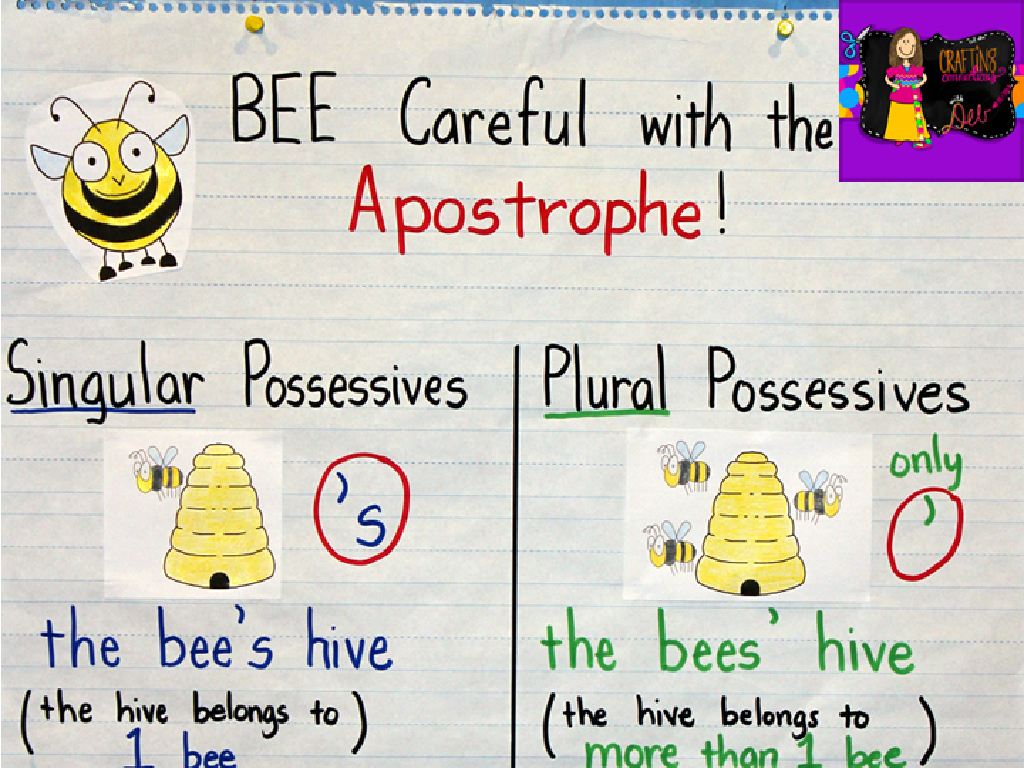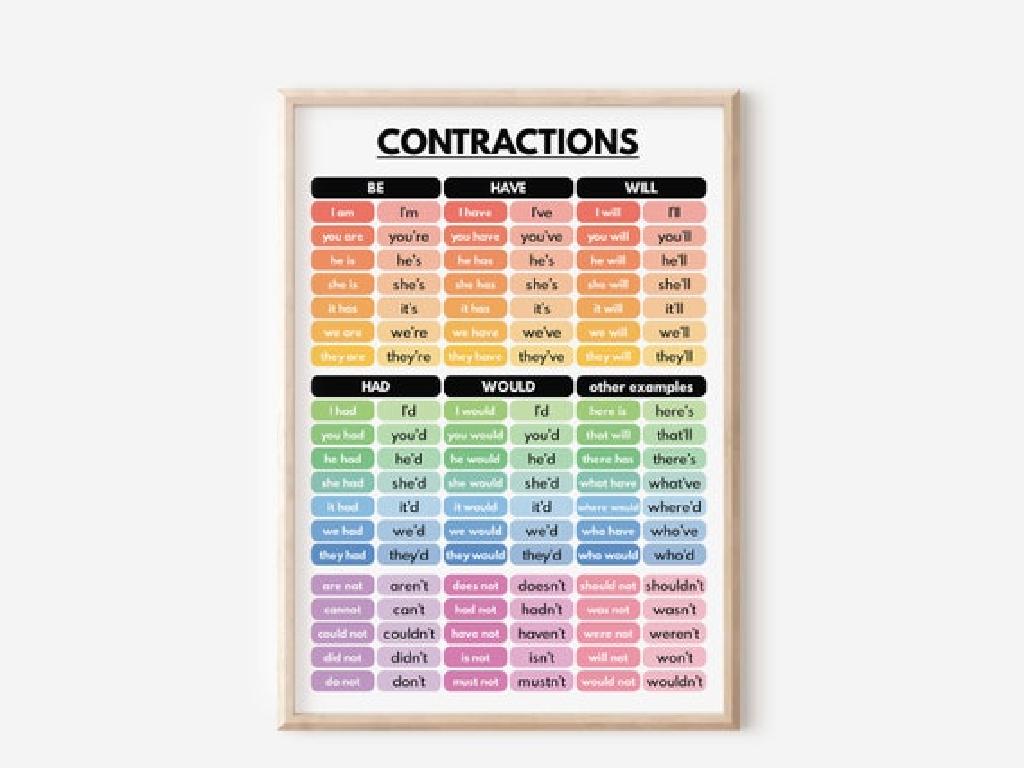Identify Vertebrates And Invertebrates
Subject: Science
Grade: Fourth grade
Topic: Classification
Please LOG IN to download the presentation. Access is available to registered users only.
View More Content
Exploring the Animal Kingdom: Classification
– Discovering the Animal Kingdom
– The Animal Kingdom is a diverse group of living organisms.
– What is Classification?
– Classification is organizing animals into groups based on similarities.
– Reasons for Classifying Animals
– To study animals easily and understand how they relate to each other.
– Vertebrates vs. Invertebrates
– Animals with backbones are vertebrates, without are invertebrates.
|
This slide introduces the concept of classification within the Animal Kingdom, aimed at fourth-grade students. Begin by explaining that the Animal Kingdom includes all types of animals, from the smallest insects to the largest whales. Classification is the method scientists use to organize these animals into groups, which makes it easier to study and understand them. Emphasize the importance of classification in understanding the relationships between different animals and how it helps us to predict characteristics and behaviors. Highlight the key difference between vertebrates and invertebrates, which is the presence or absence of a backbone. This foundational knowledge sets the stage for further exploration of animal classification.
Exploring Vertebrates
– What defines a vertebrate?
– Animals with a backbone or spinal column
– Key characteristics of vertebrates
– They have a skeleton, skull, and usually have four limbs
– Vertebrate animal examples
– Mammals like lions, birds like eagles, fish like sharks
|
This slide introduces the concept of vertebrates to fourth-grade students. Begin by defining vertebrates as animals that possess a backbone or spinal column, which is a central support structure. Discuss the key characteristics such as having a skeleton, a skull to protect the brain, and in most cases, four limbs. Provide examples of vertebrate animals from different categories like mammals, birds, and fish to help students relate to the topic. Encourage students to think of other animals they know and classify them as vertebrates or invertebrates. This will help solidify their understanding of the classification of animals based on the presence or absence of a vertebral column.
Exploring Invertebrates
– What are invertebrates?
– Animals without a backbone
– Key characteristics
– They have no bones, many live in water or on land
– Invertebrate examples
– Insects, spiders, worms, and jellyfish
– Understanding diversity
|
This slide introduces the concept of invertebrates to fourth-grade students. Begin by defining invertebrates as animals that do not have a backbone, distinguishing them from vertebrates. Discuss their characteristics, such as the lack of a bony skeleton, which can lead to a variety of body structures and adaptations. Provide examples like insects, spiders, worms, and jellyfish to help students visualize and understand the diversity within invertebrate animals. Emphasize that invertebrates can be found in many environments, from deep oceans to our own backyards. Encourage students to think of other examples and consider the roles these creatures play in their habitats.
Comparing Vertebrates and Invertebrates
– Similarities of Vertebrates & Invertebrates
– Both are animals, can move, and have similar life processes.
– Key Differences to note
– Vertebrates have a backbone; invertebrates do not.
– Significance of these differences
– Understanding helps us study animal biology & ecosystem roles.
|
This slide aims to help students understand the basic classification of animals into vertebrates and invertebrates. Start by discussing the similarities, such as both being living animals that can move and have similar life processes like respiration and reproduction. Then, highlight the main difference: vertebrates have a backbone, while invertebrates do not. Emphasize the importance of this distinction in the study of biology and how it helps us understand the roles these animals play in their ecosystems. Encourage students to think of examples of each and consider how the presence or absence of a backbone might affect the animal’s life.
Group Activity: Classifying Animals
– Work in groups to classify animals
– Each group gets animal pictures
– Decide if animals are vertebrates or invertebrates
– Vertebrates have a spine, invertebrates do not
– Discuss findings with the class
|
This group activity is designed to help students apply their knowledge of animal classification in a collaborative setting. Divide the class into small groups and provide each group with a set of animal pictures. Students will discuss within their groups to determine whether each animal is a vertebrate (having a backbone) or an invertebrate (lacking a backbone). After the activity, each group will share their findings with the class, allowing for discussion and reinforcement of the concepts. Possible variations of the activity could include sorting animals into subcategories of vertebrates (fish, amphibians, reptiles, birds, mammals) or invertebrates (insects, arachnids, mollusks, crustaceans, echinoderms), or even creating a poster or presentation based on their classifications.
Show and Tell: Vertebrates vs. Invertebrates
– Groups present their findings
– Discuss classification reasons
– Why did you decide an animal is a vertebrate or invertebrate?
– Class votes on best classification
– Reflect on the learning experience
– Think about what you’ve learned from your classmates.
|
This slide sets the stage for a class activity where students will engage in a ‘Show and Tell’ to present their findings on vertebrates and invertebrates. Each group will explain the rationale behind their classification, promoting critical thinking and understanding of the characteristics that distinguish vertebrates from invertebrates. After presentations, the class will vote on which group provided the most accurate classification, turning this into a collaborative and competitive learning experience. As a teacher, facilitate the discussion and ensure that each group justifies their reasoning based on scientific facts. Encourage students to listen carefully to their peers and to consider the evidence presented before casting their votes. This activity will reinforce the lesson’s objectives and help students better retain the information.
Conclusion: Vertebrates & Invertebrates
– Recap: Vertebrates vs. Invertebrates
– Vertebrates have a spine, invertebrates do not.
– Importance of Classification
– Helps us understand and organize the diversity of life.
– Preview: Exploring Habitats
– Next, we’ll learn where these animals live.
– Review and Reflect
|
As we wrap up today’s lesson, let’s revisit the key points: the difference between vertebrates and invertebrates, and the significance of classifying organisms. Understanding classification helps us to better study and protect these animals. Looking ahead, we’ll explore the various habitats these creatures call home, which will help us appreciate the importance of each species in its ecosystem. Encourage the students to think about the animals we discussed today and imagine what kind of habitats they might live in. This will set the stage for our next exciting topic!
Class Activity: Animal Sorting Game
– Sort animals into groups
– Use what we learned today
– Work together in teams
– Winning team classifies the most
|
This activity is designed to reinforce the day’s lesson on vertebrates and invertebrates. Divide the class into small teams and provide each team with a mixed set of animal cards or pictures. Students must work together to sort these animals into two groups: those with backbones (vertebrates) and those without (invertebrates). This game encourages collaboration and application of knowledge. To assist, prepare a list of animals beforehand and ensure there’s a good mix of common and uncommon examples. Consider having a prize for the winning team to motivate participation. Possible variations of the activity could include sorting by specific vertebrate classes (mammals, birds, etc.) or having students explain their reasoning for each classification to foster deeper understanding.






